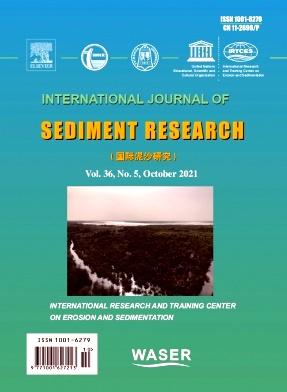Experimental study on scour around beveled submerged vanes
IF 3.7
2区 环境科学与生态学
Q2 ENVIRONMENTAL SCIENCES
引用次数: 0
Abstract
Submerged vanes are an effective approach to sediment management in river systems. Nowadays, submerged vanes are increasingly utilized in contemporary river engineering due to their convenient and cost-effective installation, which distinguishes them from traditional approaches. However, this structure induces localized scour, which can potentially destabilize and compromise its integrity. The performance and effectiveness of a submerged vane in controlling scour and managing sediment depends on its shape and dimensions. The primary aim of this study is to refine the design of submerged vanes to assess the maximum scour depth in their vicinity and changes in bed morphology downstream of the vane. We carried out 95 experimental runs in clear-water conditions to investigate the influence of vane height, bevel angle, angle of flow attack, and flow regime on the maximum scour depth in the vicinity and downstream of the vane. Results show that the maximum scour depth increases with the increase in the angle of attack, vane height-to-depth ratio, and densimetric Froude number. The depth of scour around the vane and downstream in the channel decreases as the bevel angle increases. We propose empirical equations for calculating the maximum scour depth near the vane and downstream at equilibrium condition. The densimetric Froude number of the flow and the angle of flow attack are found to have the largest influence on maximum scour depth and downstream extension. The findings indicate that the bevel shape is effective method to reduces the maximum scour depth around the vane.
坡面浸没叶片冲刷试验研究
沉叶是水系泥沙治理的有效手段。目前,水下叶片因其安装方便、成本效益高,与传统方法不同,在当代河流工程中得到越来越多的应用。然而,这种结构引起局部冲刷,这可能会破坏其稳定性并损害其完整性。水下叶片在控制冲刷和管理泥沙方面的性能和有效性取决于其形状和尺寸。本研究的主要目的是改进水下叶片的设计,以评估叶片附近的最大冲刷深度和叶片下游河床形态的变化。我们在清水条件下进行了95次实验,以研究叶片高度、倾斜角、气流攻角和流动形式对叶片附近和下游最大冲刷深度的影响。结果表明:最大冲刷深度随迎角、叶片高深比和密度弗劳德数的增大而增大;叶片周围和通道下游的冲刷深度随着斜角的增大而减小。我们提出了计算叶片附近和下游平衡状态下最大冲刷深度的经验公式。流动的密度弗劳德数和流动攻角对最大冲刷深度和向下游延伸的影响最大。研究结果表明,采用斜面形状是减小叶片周围最大冲刷深度的有效方法。
本文章由计算机程序翻译,如有差异,请以英文原文为准。
求助全文
约1分钟内获得全文
求助全文
来源期刊
CiteScore
6.90
自引率
5.60%
发文量
88
审稿时长
74 days
期刊介绍:
International Journal of Sediment Research, the Official Journal of The International Research and Training Center on Erosion and Sedimentation and The World Association for Sedimentation and Erosion Research, publishes scientific and technical papers on all aspects of erosion and sedimentation interpreted in its widest sense.
The subject matter is to include not only the mechanics of sediment transport and fluvial processes, but also what is related to geography, geomorphology, soil erosion, watershed management, sedimentology, environmental and ecological impacts of sedimentation, social and economical effects of sedimentation and its assessment, etc. Special attention is paid to engineering problems related to sedimentation and erosion.

 求助内容:
求助内容: 应助结果提醒方式:
应助结果提醒方式:


